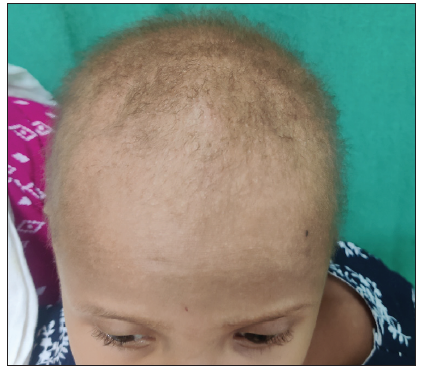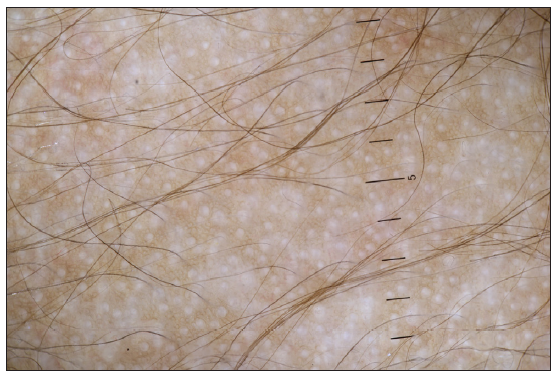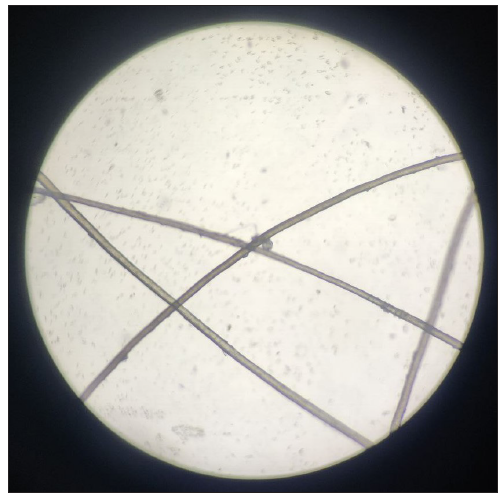Translate this page into:
Hypotrichosis simplex type 7: A rare cause of non-syndromic woolly hair
Corresponding author: Dr. Biswanath Behera, Department of Dermatology, A.I.I.M.S, Bhubaneswar, Sijua, Patrapada, Odisha, India. biswanathbehera61@gmail.com
-
Received: ,
Accepted: ,
How to cite this article: Gupta P, Sangwan P, Thakur V, Behera B. Hypotrichosis simplex type 7: A rare cause of non-syndromic woolly hair. Indian J Dermatol Venereol Leprol. doi: 10.25259/IJDVL_342_2024
Dear Editor,
Congenital hypotrichosis, which can be diffuse or localised, refers to either a reduction or complete absence of hair. It usually affects the scalp with or without the involvement of other hair-bearing sites. Herein, we describe a rare case of hypotrichosis simplex type 7 in a girl child associated with an uncommon mutation.
A 3-year-old girl born to a non-consanguineous healthy couple presented with a generalised sparseness of hair over the scalp, eyebrows, and eyelashes since three months of age. The child’s growth and development were normal as per age and the parents denied any history of neurological abnormality, recurrent infections, or frequent hospital admissions. Examination showed sparse, lightly pigmented, and curly scalp hair [Figure 1a]. The eyebrows, eyelashes, and body hair were also sparse. There was no pigment dilution of the skin or iris and teeth, nails, and sweating was normal. There were no scalp erosions, palmoplantar keratoderma, milia, or keratotic papules. Dermoscopy of the scalp hair showed decrease hair density, pigment dilution and hair shaft thinning without any shaft abnormalities [Figure 1b]. Hair microscopy failed to reveal any hair shaft disorder or pigment clumping [Figure 1c]. Haematological and biochemical investigations were within normal limits. Next-generation sequencing was done to evaluate for generalised hypotrichosis from the blood sample of the child, which revealed homozygous 1 base pair deletion c.565del in exon 4 of the LIPH (Lipase domain of LIPH protein) gene located on chromosome 3, resulting in a frameshift mutation and premature truncation of the protein 5 amino acids downstream to codon 189 in LIPH protein, confirming the diagnosis of hypotrichosis simplex type 7.1 Counseling of the parents was done and topical minoxidil treatment was started.

- Hypopigmented, sparse hair over the scalp.

- Dermoscopic image of the scalp showed pigment dilution and thinning of hair (Dermlite DL4 10x, polarised mode).

- Hair shaft light showing no shaft abnormality or pigment clumping (light microscopy, 400x).
Congenital hypotrichosis has been classified into 15 types on the basis of the pattern of alopecia and genetic mutation.2 Localised autosomal recessive hypotrichosis (LAH) is characterised by short, fragile, and sparse hair over the scalp, eyebrows, eyelashes, and other body parts. LAH 1 results from a mutation in the gene encoding desmoglein 4 (DSG4) which maps to chromosomes 18q12.1.1 LAH3 is due to a mutation in the gene encoding lysophosphatidic acid receptor 6 (LPAR6) located on chromosome 13q14.11–13q21.32.1 LAH 2 or hypotrichosis simplex 7 or autosomal recessive hypotrichosis with woolly hair (HYPT7; MIM#604379) is a rare type of congenital alopecia occurring due to LIPH gene mutation in the HYPT7 locus on chromosome 3q27.2.1 The LIPH gene encodes membrane-associated phosphatidic acid-preferring phospholipase A1α (PA-PLA1α) and contains 10 exons. It is expressed in several tissues, including the testis, ovary, pancreas, kidney, lung, spleen, brain, heart, and Henle and Huxley layer of the hair follicle. Hypotrichosis simplex type 7 is characterised by sparse woolly hair over the scalp with normal to sparse eyebrows, eyelashes, axillary, and body hair. However, beard hair in male patients are normal. Unlike in our case, some patients may demonstrate hair shaft abnormalities, including trichorrhexis nodosa on microscopy. LIPH mutation might also be associated with abnormal facial development, cleft palate, hearing difficulty, and amblyopia, which were not seen in our case.3
Woolly hair, a rare congenital hair disorder, is recognised by the presence of tightly coiled hair present focally or diffusely on the scalp. From the clinical point of view, differentiating syndromic and non-syndromic woolly hair disorders is of utmost importance. The following are the various causes of woolly hair: non-syndromic hypotrichosis group of disorders such as LIPH, lysophosphatidic acid receptor (LPAR), keratin (KRT) 71 and (KRT) 74; syndromic palmoplantar keratoderma such as Naxos syndrome and Carvajal syndrome, trichohepatoenteric syndrome; woolly hair nevus; and acquired woolly hair.1
Differential diagnoses for pigment dilution in the hair include disorders such as Menkes disease, Griscelli syndrome, Hermansky–Pudlak syndrome, Chediak–Higashi syndrome, Tietz syndrome, and Cross syndrome. However, the absence of other features such as cherubic facies, high-arched palate, hair shaft abnormalities, ocular abnormalities, hearing loss, and history suggestive of recurrent infections or bleeding manifestations helped us to exclude these conditions. There is no definitive treatment for congenital hypotrichosis. LIPH-associated hypotrichosis has been reported to improve with age.4 There are few reports of successful treatment with oral minoxidil in combination with growth factors.5 Other treatment options include topical gentamicin, bimatoprost, or topical minoxidil.6,7 However, in view of the limited efficacy of medications, camouflage using a wig or hairpiece is apparently the best option.
In conclusion, we report a rare case of hypotrichosis simplex type 7 which has not been previously reported from India. This case highlights the importance of performing a genetic analysis in diagnosing this non-syndromic cause of alopecia associated with curly or woolly hair.
Declaration of patient consent
The authors certify that they have obtained all appropriate patient consent.
Financial support and sponsorship
Nil.
Conflicts of interest
There are no conflicts of interest.
Use of artificial intelligence (AI)-assisted technology for manuscript preparation
The authors confirm that there was no use of artificial intelligence (AI)-assisted technology for assisting in the writing or editing of the manuscript and no images were manipulated using AI.
References
- A review of genotrichoses and hair pathology associated with inherited skin diseases. Br J Dermatol. 2023;189:154-60.
- [CrossRef] [PubMed] [Google Scholar]
- Familial hypotrichosis simplex of the scalp associated with a novel heterozygous nonsense variant in CDSN. Clin Exp Dermatol. 2023;48:579-83.
- [CrossRef] [PubMed] [Google Scholar]
- A homozygous mutation, c.736T>A (p.C246S), in LIPH gene in a patient manifesting woolly hair, hypotrichosis, hearing difficulty, cleft palate and amblyopia. Eur J Dermatol. 2014;24:272-3.
- [CrossRef] [PubMed] [Google Scholar]
- Identification of factors contributing to phenotypic divergence via quantitative image analyses of autosomal recessive woolly hair/hypotrichosis with homozygous c.736T>A LIPH mutation. Br J Dermatol. 2017;176:138-44.
- [CrossRef] [PubMed] [Google Scholar]
- Treatment of hereditary hypotrichosis simplex of the scalp with oral minoxidil and growth factors. Dermatol Ther. 2022;35:e15671.
- [CrossRef] [PubMed] [PubMed Central] [Google Scholar]
- Treatment of hereditary hypotrichosis simplex of the scalp with topical gentamicin. Br J Dermatol. 2020;183:114-20.
- [CrossRef] [PubMed] [Google Scholar]
- Therapeutic potential of bimatoprost for the treatment of eyebrow hypotrichosis. Drug Des Devel Ther. 2018;12:365-72.
- [CrossRef] [PubMed] [PubMed Central] [Google Scholar]





